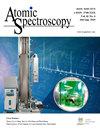从月球复合样品中联合分离铁、钙和镁用于高精度同位素分析
IF 2.3
2区 化学
Q1 SPECTROSCOPY
引用次数: 0
摘要
:Fe、Ca和Mg同位素已应用于阿波罗和月球样本,以探索月球的起源和演化。在以前的大多数研究中,只有一种特定元素被分离出来并测量其同位素组成,从而消耗了不同的样本。考虑到月球样品的稀有性和珍贵性,本文提出了一种三步纯化方案,从一份样品溶液中分离Fe、Ca和Mg,这些元素的含量分别降至20、15和10μg。首先在HCl介质中使用0.4mL AG1-X8树脂收集Fe。然后使来自含有Ca和Mg的第一个柱的基质通过填充有0.4mL DGA树脂的柱,其中Mg用11.5mL 4N HNO3洗脱,Ca用10mL 8N HNO3+0.2N HF定量回收。然后在1N HNO3介质中使用AG50W-X8纯化Mg。Fe和Mg同位素分析通过多收集器电感耦合等离子体质谱法(MC-ICP-MS)进行,Ca同位素数据通过Triton Plus热电离质谱法(TIMS)获得,遵循先前在同一实验室建立的程序。整个过程中Fe、Ca和Mg的定量回收由十个类似于阿波罗任务代表性月球样品的复合样品证明。复合样品的δ56Fe、δ44/42Ca和δ26Mg的位移分别为-0.003±0.013‰(2SD,N=30)、-0.007±0.028‰(2SD,N=7)和0.006±0.015‰(2S德,N=29),确保了Fe、Ca和Mg同位素组合分析程序的高精度和准确性。通过对三种表征良好的国际参考材料(BCR-2、BHVO-2和W-2a)的重复分析,进一步评估了该程序的稳健性,结果与之前公布的值一致。本文建立的程序使我们能够从珍贵的地外样本的单个分裂中获得Fe、Ca和Mg同位素的组合数据集,从而为其母体(如月球)的起源和演化提供新的见解。本文章由计算机程序翻译,如有差异,请以英文原文为准。
Combined Separation Of Iron, Calcium, And Magnesium From Composite Lunar Samples For High-Precision Isotope Analyses
: Fe, Ca, and Mg isotopes have been applied to Apollo and Luna samples in order to explore the origin and evolution of the Moon. In most previous studies, only one specific element was separated and measured for its isotope compositions, thereby consuming different splits of samples. Considering the rarity and preciousness of lunar samples, herein we present a three-step purification scheme to separate Fe, Ca, and Mg from a single aliquot of sample solutions with the amounts of these elements down to 20, 15, and 10 μg, respectively. Fe was first collected using 0.4 mL of AG1-X8 resin in a HCl medium. Matrices from the first column containing Ca and Mg were then passed through columns filled with 0.4 mL of DGA resin, with Mg being eluted by 11.5 mL of 4N HNO 3 , and Ca being quantitatively recovered by 10 mL of 8N HNO 3 + 0.2N HF. Mg was then purified using AG50W-X8 in a 1N HNO 3 medium. Fe and Mg isotope analyses were conducted by multi-collector inductively coupled plasma mass spectrometry (MC-ICP-MS), and Ca isotope data were obtained by Triton Plus thermal ionization mass spectrometry (TIMS) following procedures previously established in the same laboratory. Quantitative recovery of Fe, Ca, and Mg for the entire procedure was demonstrated by ten composite samples analogous to the representative lunar samples from the Apollo missions. The shifts in δ 56 Fe, δ 44/42 Ca, and δ 26 Mg of the composite samples were -0.003 ± 0.013‰ (2SD, N = 30), -0.007 ± 0.028‰ (2SD, N = 7), and 0.006 ± 0.015‰ (2SD, N = 29), respectively, ensuring high precision and accuracy of the procedure for combined Fe, Ca, and Mg isotope analyses. The robustness of the procedure was further assessed by replicate analyses of three well-characterized international reference materials (BCR-2, BHVO-2, and W-2a), and the results were consistent with previously published values. The procedure established herein allowed us to obtain combined Fe, Ca, and Mg isotopic datasets from single splits of precious extra-terrestrial samples, thereby providing new insights into the origin and evolution of their parent bodies ( e.g. , the Moon).
求助全文
通过发布文献求助,成功后即可免费获取论文全文。
去求助
来源期刊

Atomic Spectroscopy
物理-光谱学
CiteScore
5.30
自引率
14.70%
发文量
42
审稿时长
4.5 months
期刊介绍:
The ATOMIC SPECTROSCOPY is a peer-reviewed international journal started in 1962 by Dr. Walter Slavin and now is published by Atomic Spectroscopy Press Limited (ASPL). It is intended for the rapid publication of both original articles and review articles in the fields of AAS, AFS, ICP-OES, ICP-MS, GD-MS, TIMS, SIMS, AMS, LIBS, XRF and related techniques. Manuscripts dealing with (i) instrumentation & fundamentals, (ii) methodology development & applications, and (iii) standard reference materials (SRMs) development can be submitted for publication.
 求助内容:
求助内容: 应助结果提醒方式:
应助结果提醒方式:


